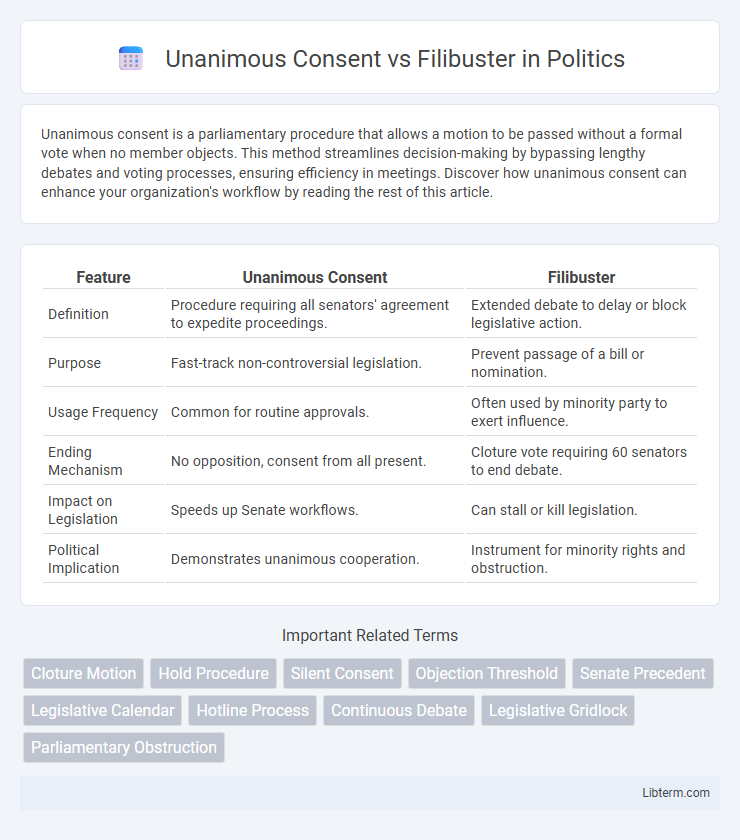Unanimous consent is a parliamentary procedure that allows a motion to be passed without a formal vote when no member objects. This method streamlines decision-making by bypassing lengthy debates and voting processes, ensuring efficiency in meetings. Discover how unanimous consent can enhance your organization's workflow by reading the rest of this article.
Table of Comparison
| Feature | Unanimous Consent | Filibuster |
|---|---|---|
| Definition | Procedure requiring all senators' agreement to expedite proceedings. | Extended debate to delay or block legislative action. |
| Purpose | Fast-track non-controversial legislation. | Prevent passage of a bill or nomination. |
| Usage Frequency | Common for routine approvals. | Often used by minority party to exert influence. |
| Ending Mechanism | No opposition, consent from all present. | Cloture vote requiring 60 senators to end debate. |
| Impact on Legislation | Speeds up Senate workflows. | Can stall or kill legislation. |
| Political Implication | Demonstrates unanimous cooperation. | Instrument for minority rights and obstruction. |
Introduction to Senate Procedures
Unanimous consent in the Senate allows for expedited proceedings by bypassing formal rules when no member objects, streamlining the legislative process. The filibuster, a procedural tactic used to extend debate and delay or block voting, requires a supermajority of 60 votes to invoke cloture and end discussion. Both methods critically shape Senate operations, influencing how legislation is debated and passed.
Defining Unanimous Consent
Unanimous consent is a parliamentary procedure where no member objects to a proposal, allowing swift approval without formal voting. This contrasts with a filibuster, which is a tactic used to delay or block legislative action by extending debate. Understanding unanimous consent highlights its role in expediting decision-making processes in legislative bodies.
Understanding the Filibuster
The filibuster is a legislative tactic used in the U.S. Senate to delay or block a vote by extending debate, requiring a supermajority of 60 senators to invoke cloture and end discussion. In contrast, unanimous consent expedites proceedings by allowing the Senate to agree on a measure without objection, streamlining the legislative process. Understanding the filibuster reveals its role as a powerful minority tool that shapes Senate negotiations and impacts the passage of significant legislation.
Historical Origins and Evolution
The filibuster originated in the early 19th century as a Senate tactic to extend debate indefinitely, allowing minority voices to block legislation, while unanimous consent emerged as a procedural shortcut enabling swift Senate agreement without formal votes. Over time, the filibuster evolved from sporadic use into a powerful tool impacting legislative gridlock, especially after the introduction of the cloture rule in 1917, which requires a supermajority to end debate. Unanimous consent agreements, on the other hand, remain vital for managing Senate business efficiently, relying on all members' agreement to expedite proceedings without invoking the filibuster's extensive delays.
How Unanimous Consent Works
Unanimous consent allows the U.S. Senate to expedite proceedings by agreeing to a proposal without formal vote, provided no senator objects. This procedure facilitates swift passage of routine measures, nominations, or non-controversial bills by bypassing extended debates and voting delays. Each senator holds the power to block unanimous consent, making it a tool dependent on complete agreement to maintain Senate efficiency.
How the Filibuster Operates
The filibuster operates as a Senate procedure that allows a minority of senators to delay or block legislative action by extending debate indefinitely, requiring a supermajority of 60 votes to invoke cloture and end discussion. Unlike unanimous consent, which expedites the legislative process by allowing a single objection to halt proceedings, the filibuster empowers the minority to maintain leverage and negotiate changes to bills. This procedural tool impacts the pace and outcome of legislation by enabling prolonged debate and strategic obstruction.
Key Differences Between Unanimous Consent and Filibuster
Unanimous consent allows the Senate to expedite proceedings by agreeing to a proposal without objections, requiring every senator's approval, whereas a filibuster permits any senator to prolong debate and delay or block legislation unless a supermajority of 60 votes invokes cloture to end it. The key difference lies in unanimous consent's dependence on total agreement for swift decision-making, contrasted with the filibuster's use as a strategic tool for minority senators to extend debate and influence legislative outcomes. These procedural mechanisms reflect divergent paths to consensus-building versus obstruction within the U.S. Senate's legislative process.
Real-World Examples in Legislative History
The use of unanimous consent in the U.S. Senate often streamlines legislation, exemplified by the rapid passage of the 2017 Tax Cuts and Jobs Act where minimal opposition allowed swift approval. In contrast, the filibuster has historically served as a powerful tool for minority parties to delay or block bills, as seen in the 1964 civil rights legislation where Senate Republicans and Democrats used it to prolong debate before eventual passage. These tools highlight the strategic contrasts in legislative procedures, impacting the efficiency and outcomes of lawmaking.
Impacts on Lawmaking and Governance
Unanimous consent accelerates lawmaking by allowing swift approval of legislation without debate, fostering efficient governance and reducing procedural delays. In contrast, the filibuster empowers a minority to extend debate indefinitely, often blocking or delaying bills, which can stall legislative progress and complicate governance. The filibuster's impact frequently leads to partisan gridlock, while unanimous consent promotes consensus and streamlined decision-making in legislative bodies.
Reform Debates and the Future of Senate Rules
Debates over unanimous consent versus the filibuster center on the Senate's efficiency and minority rights, with reform advocates pushing to limit or eliminate the filibuster to prevent legislative gridlock. Proposals include instituting time limits on debate or transitioning to a majority vote system to expedite bill passage while preserving debate integrity. The future of Senate rules likely involves balancing tradition with the need for functional governance, where reforms could redefine consensus thresholds and reshape legislative strategy.
Unanimous Consent Infographic

 libterm.com
libterm.com